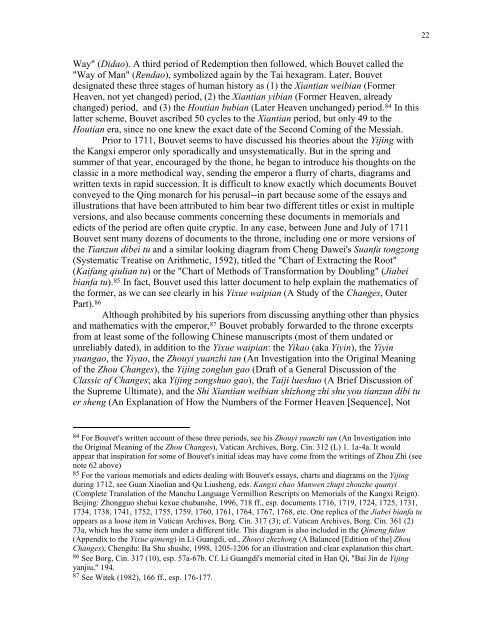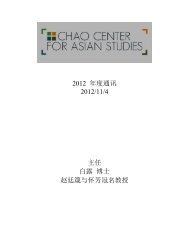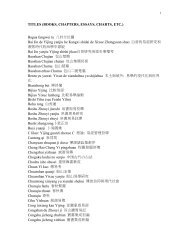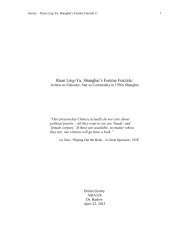Jesuit Interpretations of the Yijing - Chao Center for Asian Studies ...
Jesuit Interpretations of the Yijing - Chao Center for Asian Studies ...
Jesuit Interpretations of the Yijing - Chao Center for Asian Studies ...
Create successful ePaper yourself
Turn your PDF publications into a flip-book with our unique Google optimized e-Paper software.
22<br />
Way" (Didao). A third period <strong>of</strong> Redemption <strong>the</strong>n followed, which Bouvet called <strong>the</strong><br />
"Way <strong>of</strong> Man" (Rendao), symbolized again by <strong>the</strong> Tai hexagram. Later, Bouvet<br />
designated <strong>the</strong>se three stages <strong>of</strong> human history as (1) <strong>the</strong> Xiantian weibian (Former<br />
Heaven, not yet changed) period, (2) <strong>the</strong> Xiantian yibian (Former Heaven, already<br />
changed) period, and (3) <strong>the</strong> Houtian bubian (Later Heaven unchanged) period. 84 In this<br />
latter scheme, Bouvet ascribed 50 cycles to <strong>the</strong> Xiantian period, but only 49 to <strong>the</strong><br />
Houtian era, since no one knew <strong>the</strong> exact date <strong>of</strong> <strong>the</strong> Second Coming <strong>of</strong> <strong>the</strong> Messiah.<br />
Prior to 1711, Bouvet seems to have discussed his <strong>the</strong>ories about <strong>the</strong> <strong>Yijing</strong> with<br />
<strong>the</strong> Kangxi emperor only sporadically and unsystematically. But in <strong>the</strong> spring and<br />
summer <strong>of</strong> that year, encouraged by <strong>the</strong> thone, he began to introduce his thoughts on <strong>the</strong><br />
classic in a more methodical way, sending <strong>the</strong> emperor a flurry <strong>of</strong> charts, diagrams and<br />
written texts in rapid succession. It is difficult to know exactly which documents Bouvet<br />
conveyed to <strong>the</strong> Qing monarch <strong>for</strong> his perusal--in part because some <strong>of</strong> <strong>the</strong> essays and<br />
illustrations that have been attributed to him bear two different titles or exist in multiple<br />
versions, and also because comments concerning <strong>the</strong>se documents in memorials and<br />
edicts <strong>of</strong> <strong>the</strong> period are <strong>of</strong>ten quite cryptic. In any case, between June and July <strong>of</strong> 1711<br />
Bouvet sent many dozens <strong>of</strong> documents to <strong>the</strong> throne, including one or more versions <strong>of</strong><br />
<strong>the</strong> Tianzun dibei tu and a similar looking diagram from Cheng Dawei's Suanfa tongzong<br />
(Systematic Treatise on Arithmetic, 1592), titled <strong>the</strong> "Chart <strong>of</strong> Extracting <strong>the</strong> Root"<br />
(Kaifang qiulian tu) or <strong>the</strong> "Chart <strong>of</strong> Methods <strong>of</strong> Trans<strong>for</strong>mation by Doubling" (Jiabei<br />
bianfa tu). 85 In fact, Bouvet used this latter document to help explain <strong>the</strong> ma<strong>the</strong>matics <strong>of</strong><br />
<strong>the</strong> <strong>for</strong>mer, as we can see clearly in his Yixue waipian (A Study <strong>of</strong> <strong>the</strong> Changes, Outer<br />
Part). 86<br />
Although prohibited by his superiors from discussing anything o<strong>the</strong>r than physics<br />
and ma<strong>the</strong>matics with <strong>the</strong> emperor, 87 Bouvet probably <strong>for</strong>warded to <strong>the</strong> throne excerpts<br />
from at least some <strong>of</strong> <strong>the</strong> following Chinese manuscripts (most <strong>of</strong> <strong>the</strong>m undated or<br />
unreliably dated), in addition to <strong>the</strong> Yixue waipian: <strong>the</strong> Yikao (aka Yiyin), <strong>the</strong> Yiyin<br />
yuangao, <strong>the</strong> Yiyao, <strong>the</strong> Zhouyi yuanzhi tan (An Investigation into <strong>the</strong> Original Meaning<br />
<strong>of</strong> <strong>the</strong> Zhou Changes), <strong>the</strong> <strong>Yijing</strong> zonglun gao (Draft <strong>of</strong> a General Discussion <strong>of</strong> <strong>the</strong><br />
Classic <strong>of</strong> Changes; aka <strong>Yijing</strong> zongshuo gao), <strong>the</strong> Taiji lueshuo (A Brief Discussion <strong>of</strong><br />
<strong>the</strong> Supreme Ultimate), and <strong>the</strong> Shi Xiantian weibian shizhong zhi shu you tianzun dibi tu<br />
er sheng (An Explanation <strong>of</strong> How <strong>the</strong> Numbers <strong>of</strong> <strong>the</strong> Former Heaven [Sequence], Not<br />
84 For Bouvet's written account <strong>of</strong> <strong>the</strong>se three periods, see his Zhouyi yuanzhi tan (An Investigation into<br />
<strong>the</strong> Original Meaning <strong>of</strong> <strong>the</strong> Zhou Changes), Vatican Archives, Borg. Cin. 312 (L) 1. 1a-4a. It would<br />
appear that inspiration <strong>for</strong> some <strong>of</strong> Bouvet's initial ideas may have come from <strong>the</strong> writings <strong>of</strong> Zhou Zhi (see<br />
note 62 above)<br />
85 For <strong>the</strong> various memorials and edicts dealing with Bouvet's essays, charts and diagrams on <strong>the</strong> <strong>Yijing</strong><br />
during 1712, see Guan Xiaolian and Qu Liusheng, eds. Kangxi chao Manwen zhupi zhouzhe quanyi<br />
(Complete Translation <strong>of</strong> <strong>the</strong> Manchu Language Vermillion Rescripts on Memorials <strong>of</strong> <strong>the</strong> Kangxi Reign).<br />
Beijing: Zhongguo shehui kexue chubanshe, 1996, 718 ff., esp. documents 1716, 1719, 1724, 1725, 1731,<br />
1734, 1738, 1741, 1752, 1755, 1759, 1760, 1761, 1764, 1767, 1768, etc. One replica <strong>of</strong> <strong>the</strong> Jiabei bianfa tu<br />
appears as a loose item in Vatican Archives, Borg. Cin. 317 (3); cf. Vatican Archives, Borg. Cin. 361 (2)<br />
73a, which has <strong>the</strong> same item under a different title. This diagram is also included in <strong>the</strong> Qimeng fulun<br />
(Appendix to <strong>the</strong> Yixue qimeng) in Li Guangdi, ed., Zhouyi zhezhong (A Balanced [Edition <strong>of</strong> <strong>the</strong>] Zhou<br />
Changes), Chengdu: Ba Shu shushe, 1998, 1205-1206 <strong>for</strong> an illustration and clear explanation this chart.<br />
86 See Borg, Cin. 317 (10), esp. 57a-67b. Cf. Li Guangdi's memorial cited in Han Qi, "Bai Jin de <strong>Yijing</strong><br />
yanjiu," 194.<br />
87 See Witek (1982), 166 ff., esp. 176-177.








